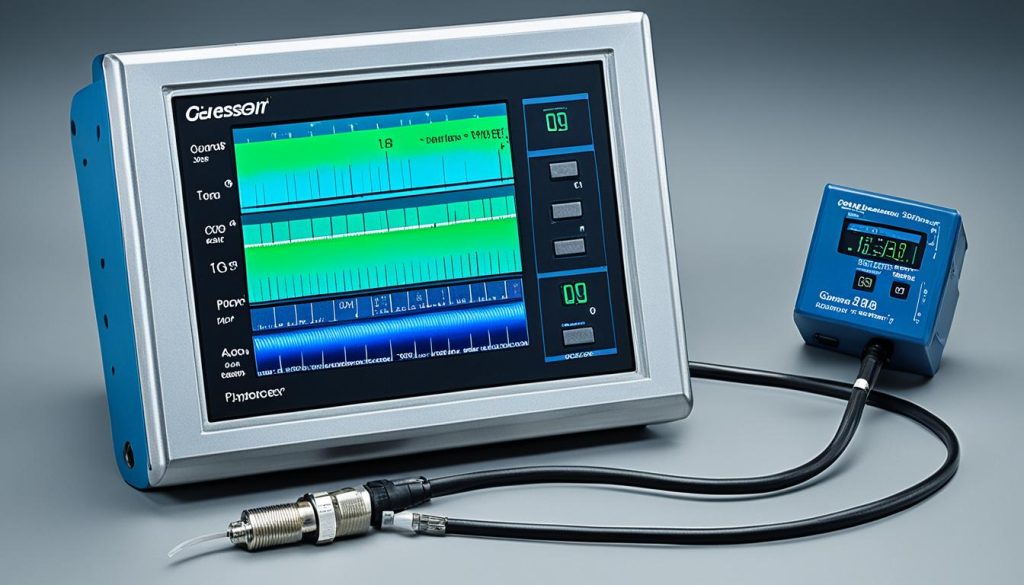Did you know that accurately measuring static pressure is essential for optimal HVAC performance?
Static pressure measurements provide valuable insights into the air distribution system, helping HVAC professionals identify airflow restrictions and ensure efficient operation. To measure static pressure accurately, it is crucial to use reliable pressure measurement devices like static pressure sensors.
Key Takeaways:
- Accurate measurement of static pressure is crucial for optimal HVAC performance.
- Static pressure sensors help HVAC professionals identify airflow restrictions.
- Proper measurement of static pressure ensures efficient operation of the system.
- Measuring static pressure allows for the identification and resolution of airflow issues.
- Static pressure measurements help determine the need for duct renovation work.
Step-by-Step Guide for Measuring Static Pressure
When it comes to measuring static pressure in a residential HVAC system, following a simple step-by-step process can ensure accurate readings. Whether you’re a professional HVAC technician or a homeowner looking to troubleshoot airflow issues, these six steps will guide you through the process.
- Locate the appropriate test port locations: Before you can measure static pressure, you need to identify the optimal locations for test ports. These ports should be strategically placed before and after components such as the coil, filter, and other vital parts of the system to measure pressure drops accurately.
- Drill the test ports: Once you’ve determined the locations for the test ports, carefully drill holes at those points. Make sure the holes are clean and smooth to ensure accurate pressure readings.
- Connect the static pressure tip to the gauge: Attach the static pressure tip to the gauge using the appropriate fittings. This will allow you to measure the pressure differentials accurately.
- Measure the supply and return static pressures: With the gauge properly connected, measure the static pressures at both the supply and return sides of the system. Record these readings for further analysis.
- Calculate the total external static pressure: Add the supply and return static pressure values together to determine the total external static pressure. This value will help in assessing the overall performance of the system.
- Ensure static pressure readings are within rated limits: It is vital to check if the static pressure readings fall within the rated limits for your equipment. Refer to the manufacturer’s specifications to verify if the pressures are within the acceptable range. This will help avoid potential issues and ensure optimal system performance.
Following these step-by-step instructions will enable you to measure static pressure accurately and gain valuable insights into your HVAC system’s performance. By understanding the static pressure calculation process and utilizing the appropriate measurement tools, you can diagnose airflow issues, troubleshoot problems, and maintain the efficiency of your residential HVAC system.
Understanding the Significance of Static Pressure Readings
Static pressure readings provide valuable insights into the performance of the HVAC system. By monitoring and analyzing static pressure, we can identify potential restrictions and ensure optimal system efficiency.
The first important aspect to consider is the comparison between the total external static pressure and the rated static pressure. This helps us determine if there are any obstructions in the air distribution system.
Excessive static pressure can lead to low fan airflow, resulting in reduced system efficiency and increased energy consumption. By measuring the static pressure, we can address any issues promptly, maintaining optimal airflow and performance.
Filter and coil pressure drops are also crucial indicators. These readings enable us to identify restrictive filters or coils that can impede the system’s performance. Regular monitoring helps ensure clean filters and efficient heat exchange, ultimately prolonging the lifespan of the HVAC equipment.
Additionally, measuring the duct system pressures is essential. It allows us to identify any restrictions in the supply or return ducts, including issues with fittings, transitions, or ductwork design. Addressing these restrictions can improve airflow, enhance comfort, and reduce overall energy consumption.
The image above depicts a cutting-edge pressure monitoring equipment that can accurately measure static pressure in various HVAC applications. With reliable static pressure units and gauges, we can ensure accurate readings and make data-driven decisions to optimize system performance.
Troubleshooting Airflow Issues with Static Pressure
When it comes to HVAC systems, static pressure measurements play a vital role in diagnosing airflow problems. By measuring static pressure, I can identify the underlying causes of airflow issues and take appropriate actions to resolve them. In this section, I will discuss the four essential static pressure readings that are necessary to troubleshoot airflow problems effectively.
To pinpoint the root cause of airflow issues, I focus on measuring four critical static pressures: total external static pressure, filter pressure drop, coil pressure drop, and duct system pressures. Each of these measurements provides valuable insights into the performance of the HVAC system.
Excessive static pressure can indicate airflow restrictions within the system. This could be due to clogged filters, blocked coils, or improperly designed ductwork. By measuring the filter pressure drop and coil pressure drop, I can identify if these components are causing an excessive increase in static pressure.
On the other hand, low static pressure may indicate leaks in the system or a low fan speed. These issues can result in inadequate airflow, leading to reduced system efficiency and comfort. By measuring the duct system pressures, I can determine if there are any restrictions within the supply or return ducts, helping me identify and resolve low static pressure problems.
The Importance of Static Pressure Transducers and Pressure Measurement Devices
To accurately measure these static pressures, I rely on specialized equipment such as static pressure transducers and other pressure measurement devices. These tools provide precise and reliable readings that enable me to diagnose and troubleshoot airflow problems effectively.
Static pressure transducers are designed specifically for static pressure measurements in HVAC systems. They offer high accuracy and durability, ensuring consistent performance in demanding environments. These transducers convert pressure into an electrical signal, which can then be measured and analyzed.
By utilizing these advanced pressure measurement devices, I can gather valuable data to evaluate the performance of the HVAC system. This data helps me make informed decisions and take the necessary steps to optimize airflow, improve energy efficiency, and enhance overall system performance.

In the image above, you can see an example of a static pressure transducer. Its compact and robust design allows for easy installation and accurate measurements, providing a valuable tool for troubleshooting airflow issues.
Through the careful measurement of static pressures and the use of reliable pressure measurement devices, I can effectively diagnose and resolve airflow problems in HVAC systems. By addressing these issues, I ensure optimal system performance, improved energy efficiency, and enhanced comfort for the end-users.
The Importance of Proper Duct Design and Balancing
When it comes to HVAC systems, proper duct design and balancing play a critical role in ensuring comfort and efficiency. As an HVAC professional, I understand the significance of a well-designed, installed, and balanced duct system. One key tool that helps me achieve optimal system performance is the static pressure transducer, along with other pressure measurement devices.
By measuring static pressure, I gain valuable insights into the performance of the duct system. This allows me to identify any potential issues and make informed decisions regarding duct renovation work. With the help of static pressure measurements, I can ensure that the airflow within the ducts is balanced, resulting in efficient temperature regulation throughout the entire space.
Not only does a properly designed and balanced duct system enhance comfort, but it also contributes to energy efficiency. By optimizing the airflow, HVAC professionals can minimize energy consumption and reduce utility costs for their customers. Additionally, a well-designed duct system prolongs the lifespan of the HVAC equipment, saving both time and money in the long run.
When it comes to providing exceptional HVAC services, focusing on the duct system sets me apart from the competition. By utilizing static pressure transducers and other pressure measurement devices, I can confidently assess the performance of the ducts and deliver the best solutions to my customers. Through proper duct design and balancing, I strive to exceed expectations and offer added value to those I serve.
